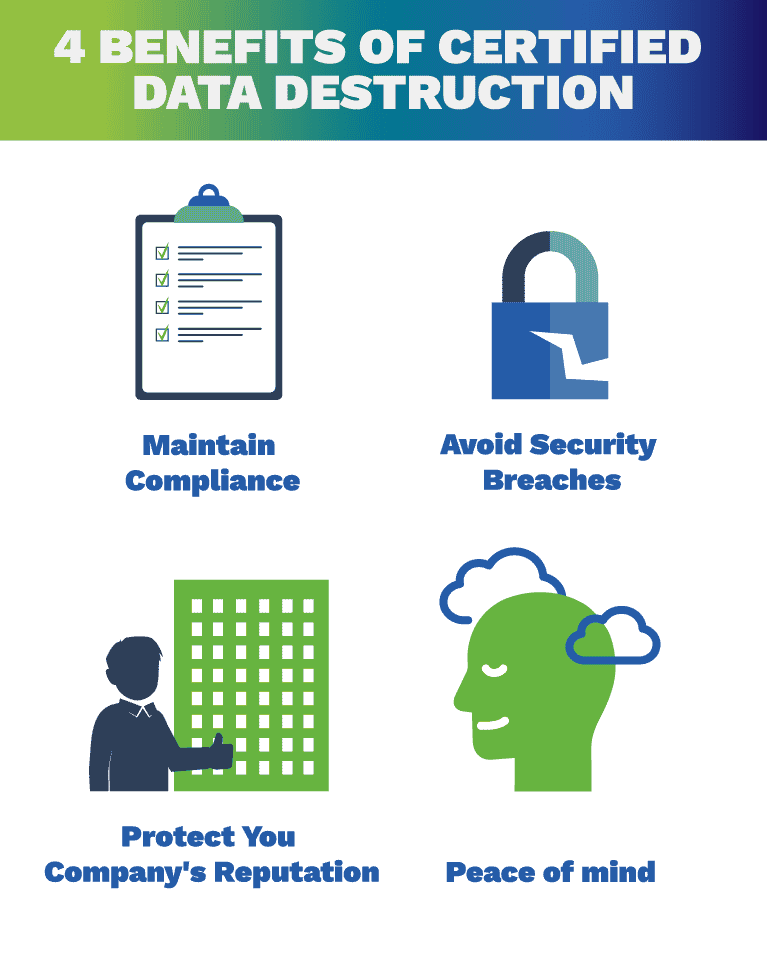Comprehending the Role of Data Destruction in Strengthening Cyber Security Defenses
Comprehending the Role of Data Destruction in Strengthening Cyber Security Defenses
Blog Article
The Importance of Effective Data Destruction Practices in Safeguarding Sensitive Information and Ensuring Computer Protection
In an era where data breaches are progressively typical, the relevance of efficient information devastation techniques can not be overstated. Executing durable information damage methods not just mitigates these risks but also straightens with legal conformity demands, ensuring that companies copyright their reputation and foster client count on.
Recognizing Data Devastation
Recognizing information destruction is vital in today's electronic landscape, where sensitive details can conveniently be endangered. Reliable information damage entails not just removing data but ensuring that data is irretrievable via comprehensive techniques. This process is vital for companies that handle personal client information, copyright, or interior documents, as any kind of breach can cause extreme monetary and reputational effects.
Data devastation encompasses numerous methods, including shredding physical media, degaussing magnetic storage tools, and using software-based services that overwrite data numerous times. Each technique serves a details purpose and needs to straighten with the sensitivity of the info being dealt with. For instance, physical damage is commonly preferred for hard disks containing highly private data, while software methods might be enough for much less delicate details.
Furthermore, adhering to market requirements and guidelines, such as the General Information Security Regulation (GDPR) or the Medical Insurance Transportability and Liability Act (HIPAA), is crucial for compliance and to minimize legal dangers. Organizations needs to create a durable data destruction policy, train workers on best techniques, and regularly audit their procedures to make sure that all sensitive info is disposed of securely and efficiently.
Threats of Inadequate Practices
Insufficient information devastation methods reveal organizations to considerable dangers that can have far-reaching effects. When sensitive details is not effectively thrown away, it continues to be vulnerable to unapproved accessibility, which can bring about data breaches and identity burglary. Such events not only compromise the security of people however likewise tarnish the organization's reputation, leading to a loss of consumer trust fund and prospective monetary repercussions.
Moreover, regulatory compliance is significantly strict in several industries. Failure to stick to information damage guidelines can cause large penalties and lawful activities against companies. These charges can stress economic sources and divert interest from core business operations.
In addition, the abuse of recurring information can result in intellectual residential property burglary or company espionage, threatening affordable advantages (data destruction). The influence of poor data damage prolongs beyond prompt monetary losses; it can likewise cause long-term damage to brand name honesty and market placement

Organizations need to acknowledge that data protection is not entirely regarding stopping violations; it additionally incorporates the liable administration of data throughout its lifecycle. Neglecting effective information damage procedures can have tragic ramifications, underscoring the necessity for durable steps to minimize these threats.
Ideal Practices for Data Destruction
Implementing reliable information devastation techniques is important for safeguarding sensitive details and preserving compliance with regulatory standards. Organizations should take on a multi-faceted method to make certain that data is irretrievable, therefore preventing unauthorized accessibility and possible violations.
First, information must be categorized based on sensitivity, allowing organizations to apply suitable damage techniques tailored to the degree of risk. For electronic information, making use of software-based data-wiping devices that adhere to industry requirements can successfully overwrite existing data. Physical destruction techniques, such as shredding or degaussing, are vital for gadgets that save delicate info, making certain full obliteration.
Establishing a clear information retention plan is important, describing for how long various types published here of details ought to be maintained prior to devastation. Regular audits of information storage space systems are additionally required to identify obsolete or unneeded information requiring removal.
Furthermore, training employees on the relevance of data damage and the specific methods to comply with fosters a culture of safety and security within the company. Finally, maintaining documentation of data damage refines provides responsibility and supports conformity with interior plans and outside laws. By adhering to these finest techniques, companies can substantially reduce the dangers related to information direct exposure.
Legal and Compliance Considerations

Failing to abide by these guidelines can lead to extreme penalties, including significant fines and reputational damage. Organizations has to implement a robust data damage plan that lines up with these legal structures and gives clear standards on the correct approaches of data disposal, whether physical shredding or digital cleaning.
Furthermore, maintaining documents of data devastation activities is vital for showing compliance during audits or assessments. By prioritizing legal and conformity factors useful site to consider, companies can improve their information security position and foster count on with stakeholders and customers, inevitably adding to a much more protected data monitoring environment.
Benefits of Effective Information Destruction
Reliable data damage methods extend beyond simple compliance; they use significant advantages to companies that prioritize them. By guaranteeing that delicate info is irretrievably ruined, organizations reduce the threat of information violations and the potential financial effects linked with them. This positive technique not just safeguards against unauthorized accessibility however additionally improves the general dependability of the organization in the eyes of stakeholders and customers.
Applying robust data devastation approaches, such as physical damage of storage tools or sophisticated information wiping techniques, adds to the conditioning of an organization's cybersecurity stance. data destruction. It minimizes the possibility of intellectual building burglary and safeguards exclusive info, thereby keeping an one-upmanship in the marketplace

Conclusion
In final thought, reliable data devastation techniques are important for securing delicate information and improving total computer safety. Eventually, a commitment to durable information destruction techniques promotes a society of duty, therefore reinforcing a company's cybersecurity pose and preserving customer trust fund.

Report this page